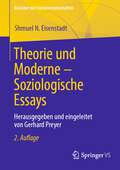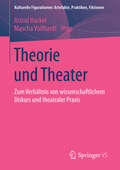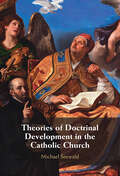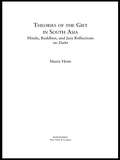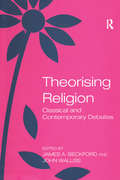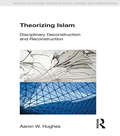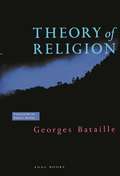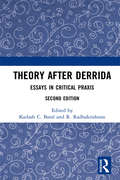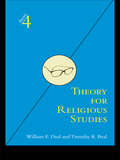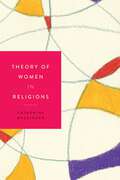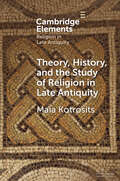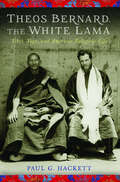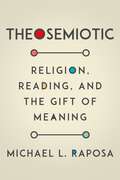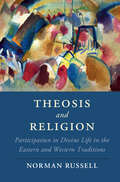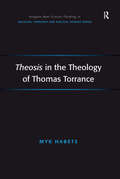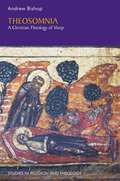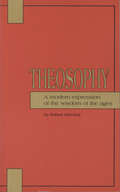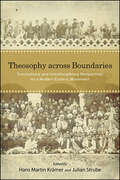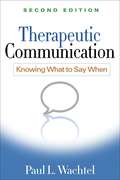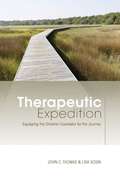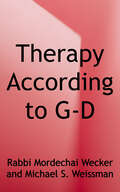- Table View
- List View
Theorie und Moderne – Soziologische Essays: Herausgegeben und eingeleitet von Gerhard Preyer (Klassiker der Sozialwissenschaften)
by Shmuel N. EisenstadtDer Band versammelt wichtige Texte von Eisenstadt zum Thema "Soziologische Theorie und Moderne", die das gesamte Spektrum der umfassenden Forschungen von Eisenstadt repräsentieren.
Theorie und Theater: Zum Verhältnis von wissenschaftlichem Diskurs und theatraler Praxis (Kulturelle Figurationen: Artefakte, Praktiken, Fiktionen)
by Astrid Hackel and Mascha VollhardtDie Theaterwissenschaft beruft sich gern auf den gemeinsamen Ursprung von Theorie und Theater. Ein Grund zu fragen, auf welche Weise akademische Diskurse Eingang in zeitgenössische Performances, Tanz- und Theaterinszenierungen finden und was diese umgekehrt zur Vermittlung oder sinnlichen Fremdwerdung theoretischen Wissens beitragen können. Untersucht werden die zahlreichen Verflechtungen und Unwägbarkeiten zwischen Theorie und Theater, die szenische Selbstreferenzialität und Widerständigkeit gegen die eigene Theoretisierbarkeit, die Herausforderungen im Umgang mit humanwissenschaftlichen, (post-)feministischen und queeren Theorien sowie der Stellenwert von Sprache, Sinn und Sinnlichkeit in zeitgenössischen Inszenierungen.
Theories of Doctrinal Development in the Catholic Church
by Michael SeewaldThe contemporary Catholic Church finds itself in deep crisis as it questions which elements are essential to the Catholic faith, and which can be changed. Bringing a longue durée perspective to this issue, Michael Seewald historicizes the problem and investigates how theologians of the past addressed it in light of the challenges that they faced in their time. He explores the intense intellectual efforts made by theologians to explain how new components were added to Christian doctrine over time, and that dogma has always been subject to change. Acknowledging the historic cleavage between 'conservatives' who refer to tradition, and reformers, who formulate their arguments to address contemporary needs, Seewald shows that Catholic thought is intellectually expansive, enabling the Church to be transformed in order to meet the challenges of the present day. His book demonstrates how theology has dealt with the realization that there is a simultaneity of continuity and discontinuity in doctrinal matters.
Theories of Illness: World Survey
by George Peter MurdockTheories of Illness establishes a new landmark in comparative studies. Utilizing concepts from modern medicine and anthropological theory, Professor Murdock distinguishes the natural causes of illness from theories of supernatural causation. He subdivides the latter into theories of illness that are related to aggression (witchcraft, sorcery, and spirit aggression) and those which are related to guilt and a sense of sin (taboo violation and mystical retribution). Obviously, these relate to man's most basic beliefs as revealed in early religions.
Theories of the Gift in South Asia: Hindu, Buddhist, and Jain Reflections on Dana (Religion in History, Society and Culture)
by Maria HeimThis book explores the ethical and social implications of unilateral gifts of esteem, offering a perceptive guide to the uniquely South Asian contributors to theoretical work on the gift.
Theorising Religion: Classical and Contemporary Debates
by John WallissReligion is controversial and challenging. Whilst religious forces are powerful in numerous societies, they have little or no significance for wide swaths of public or private life in other places. The task of theoretical work in the sociology of religion is, therefore, to make sense of this apparently paradoxical situation in which religion is simultaneously significant and insignificant. The chapters of Part One consider the classical roots of ideas about religion that dominated sociological ways of thinking about it for most of the twentieth century. Each chapter offers sound reasons for continuing to find theoretical inspiration and challenge in the sociological classics whilst also seeking ways of enhancing and extending their relevance to religion today. Part Two contains chapters that open up fresh perspectives on aspects of modern, post-modern and ultra-modern religion without necessarily ignoring the classical legacy. The chapters of Part Three chart new directions for the sociological analysis of religion by fundamentally re-thinking its theoretical basis, by extending its disciplinary boundaries and by examining previously overlooked topics.
Theorizing Islam: Disciplinary Deconstruction and Reconstruction (Religion in Culture #N)
by Aaron W. HughesThe scholarly study of Islam has become ever more insular and apologetic. Academic Islamic Studies has tried to maintain a focus on truth, authenticity, experience and meaning and has effectively avoided discussion of larger social, cultural and ideological issues. Many scholars of Islam have presented themselves to their colleagues, the media and the public as the interpreters of Islam and have done so with an interpretation which tends, almost universally, to the liberal and egalitarian. The ignorance and hostility which the Islamic faith has faced since 9/11 has partly necessitated the taking of such a position. But, as Theorizing Islam argues, the issue remains that only one interpretation of Islam is generally being presented and, as with any interpretation, this has its own assumptions. The aim of Theorizing Islam is to explore the potential for a fuller, more honest and more sophisticated approach to both theory and methodology in the academic study of Islam.
Theory Of Religion
by Robert Hurley Georges BatailleTheory of Religion brings to philosophy what Georges Bataille's earlier book The Accursed Share brought to anthropology and history, namely, an analysis based on notions of excess and expenditure. No other work of Bataille's, and perhaps no other work anywhere since Weber's Protestant Ethic and the Spirit of Capitalism, has managed to draw so incisively the links between man's religious and economic activities. <p><p> "Religion," according to Bataille, "is the search for a lost intimacy." In a brilliant and tightly reasoned argument, he proceeds to develop a "general economy" of man's relation to this intimacy: from the seamless immanence of animality to the shattered world of objects and the partial, ritual recovery of the intimate order through the violence of the sacrifice. Bataille then reflects on the archaic festival, in which he sees not only the glorious affirmation of life through destructive consumption but also the seeds of another, more ominous order -- war. <p> Bataille then traces the rise of the modern military order, in which production ceases to be oriented toward the destruction of a surplus and violence is no longer deployed inwardly but is turned to the outside. In these twin developments one can see the origins of modern capitalism.
Theory after Derrida: Essays in Critical Praxis
by R. Radhakrishnan Kailash C. BaralA critical anthology that re-examines Jacques Derrida’s thought by way of theory and praxis, this volume reflects on his striking legacy and the future of theory. Among contemporary thinkers, Derrida challenges not only our ways of thinking but also hitherto methods of inquiry. This book captures how Derrida renovates and re-energises philosophy by questioning the fundamental assumptions of Western philosophical thought. By doing so, he exposes the intricate lie behind binaries, such as speech/writing, nature/culture, male/female, black/white, literature/criticism, etc., which have continued to shape our worldview, where a hegemonic centre is always already in place dominating or marginalising the ‘other’. A significant contribution to literary theory, this book explores not only the status of Derrida’s contribution as a critical thinker but also the status of critical theory as such in the contemporary milieu. The central question that it asks is whether we should dismiss Derrida as a thinker who espoused an extreme form of relativism, bordering on nihilism, or has he something fundamental to contribute to the future of theory. Could it be that deconstruction is not destruction but a possibility that casts doubts on whether the present can have faith in future? This second edition includes a new Postscript and addresses some important concerns of our times, such as religious practice, art and aesthetics, translation, sociology of philosophy, and democracy. Scholars and researchers of English literature, philosophy, sociology and cultural studies will find this work particularly interesting.
Theory for Religious Studies (theory4)
by William E. Deal Timothy K. BealIn this handy volume, two professors of religious studies provide the student of religious studies - whether the motivated undergraduate, graduate student, or professor - with a brief review of theorists' work from the perspective of religious studies. For example, in 5-10 pages, the reader will get a review of Emmanuel Levinas's work as it offers insights for scholars in religious studies, followed by a selected bibliography. In short, this is a guide for students of religious studies that will take major theoretical writers in the humanities and social sciences and explain their relevance to the study of religion.
Theory of Women in Religions (Women in Religions #4)
by Catherine WessingerAn introduction to the study of women in diverse religious culturesWhile women have made gains in equality over the past two centuries, equality for women in many religious traditions remains contested throughout the world. In the Roman Catholic Church and the Church of Jesus Christ of Latter-day Saints women are not ordained as priests. In areas of Pakistan and Afghanistan under Taliban occupation girls and women students and their teachers risk their lives to go to school. And in Sri Lanka, fully ordained Buddhist nuns are denied the government identity cards that recognize them as citizens. Is it possible to create families, societies, and religions in which women and men are equal? And if so, what are the factors that promote equality?Theory of Women in Religions offers an economic model to shed light on the forces that have impacted the respective statuses of women and men from the earliest developmental stages of society through the present day. Catherine Wessinger integrates data and theories from anthropology, archaeology, sociology, history, gender studies, and psychology into a concise history of religions introduction to the complex relationship between gender and religion. She argues that socio-economic factors that support specific gender roles, in conjunction with religious norms and ideals, have created a gendered division of labor that both directly and indirectly reinforces gender inequality. Yet she also highlights how as the socio-economic situation is changing religion is being utilized to support the transition toward women’s equality, noting the ways in which many religious representations of gender change over time.
Theory, History, and the Study of Religion in Late Antiquity: Speculative Worlds (Elements in Religion in Late Antiquity)
by Maia KotrositsTheory is not a set of texts, it is a style of approach. It is to engage in the act of speculation: gestures of abstraction that re-imagine and dramatize the crises of living. This Element is a both a primer for understanding some of the more predominant strands of critical theory in the study of religion in late antiquity, and a history of speculative leaps in the field. It is a history of dilemmas that the field has tried to work out again and again - questions about subjectivity, the body, agency, violence, and power. This Element additionally presses us on the ethical stakes of our uses of theory, and asks how the field's interests in theory help us understand what's going on, half-spoken, in the disciplinary unconscious.
Theos Bernard, the White Lama: Tibet, Yoga, and American Religious Life
by Paul G. HackettThe life and adventures of an American explorer and iconic figure in the 20th century religious counterculture movement.In 1937, Theos Casimir Bernard, the self-proclaimed &“White Lama,&” became the third American in history to reach Lhasa, the capital city of Tibet. During his stay, he amassed the largest collection of Tibetan texts, art, and artifacts in the Western hemisphere at that time. He also documented, in both still photography and 16mm film, the age-old civilization of Tibet on the eve of its destruction by Chinese Communists. Based on thousands of primary sources and rare archival materials, this is the real story behind the purported adventures of Bernard and his role in the growth of America's religious counterculture. Over the course of his brief life, Bernard met, associated, and corresponded with the major social, political, and cultural leaders of his day, from the Regent and high politicians of Tibet to saints, scholars, and diplomats of British India, from Charles Lindbergh and Franklin Delano Roosevelt to Gandhi and Nehru. Although hailed as a brilliant pioneer by the media, Bernard also had his flaws. He was an entrepreneur propelled by grandiose schemes, a handsome man who shamelessly used his looks to bounce from rich wife to rich wife in support of his activities, and a master manipulator who concocted his own interpretation of Eastern wisdom to suit his ends. Bernard had a bright future before him but disappeared in India during the communal violence of the 1947 Partition, never to be seen again.&“Well-written…A readable intellectual account of the life of an ambitious Tibetological pioneer.&”—Asian Ethnology
Theos Bernard, the White Lama: Tibet, Yoga, and American Religious Life
by Paul HackettIn 1937, Theos Casimir Bernard (1908–1947), the self-proclaimed "White Lama," became the third American in history to reach Lhasa, the capital city of Tibet. During his stay, he amassed the largest collection of Tibetan texts, art, and artifacts in the Western hemisphere at that time. He also documented, in both still photography and 16mm film, the age-old civilization of Tibet on the eve of its destruction by Chinese Communists. Based on thousands of primary sources and rare archival materials, Theos Bernard, the White Lama recounts the real story behind the purported adventures of this iconic figure and his role in the growth of America's religious counterculture. Over the course of his brief life, Bernard met, associated, and corresponded with the major social, political, and cultural leaders of his day, from the Regent and high politicians of Tibet to saints, scholars, and diplomats of British India, from Charles Lindbergh and Franklin Delano Roosevelt to Gandhi and Nehru. Although hailed as a brilliant pioneer by the media, Bernard also had his flaws. He was an entrepreneur propelled by grandiose schemes, a handsome man who shamelessly used his looks to bounce from rich wife to rich wife in support of his activities, and a master manipulator who concocted his own interpretation of Eastern wisdom to suit his ends. Bernard had a bright future before him, but disappeared in India during the communal violence of the 1947 Partition, never to be seen again.Through diaries, interviews, and previously unstudied documents, Paul G. Hackett shares Bernard's compelling life story, along with his efforts to awaken America's religious counterculture to the unfolding events in India, the Himalayas, and Tibet. Hackett concludes with a detailed geographical and cultural trace of Bernard's Indian and Tibetan journeys, which shed rare light on the explorer's mysterious disappearance.
Theosemiotic: Religion, Reading, and the Gift of Meaning
by Michael L. RaposaIn Theosemiotic, Michael Raposa uses Charles Peirce’s semiotic theory to rethink certain issues in contemporary philosophical theology and the philosophy of religion. He first sketches a history that links Peirce’s thought to that of earlier figures (both within the tradition of American religious thought and beyond), as well as to other classical pragmatists and to later thinkers and developments. Drawing on Peirce’s ideas, Raposa develops a semiotic conception of persons/selves emphasizing the role that acts of attention play in shaping human inferences and perception. His central Peircean presuppositions are that all human experience takes the form of semiosis and that the universe is “perfused” with signs. Religious meaning emerges out of a process of continually reading and re-reading certain signs.Theology is explored here in its manifestations as inquiry, therapy, and praxis. By drawing on both Peirce’s logic of vagueness and his logic of relations, Raposa makes sense out of how we talk about God as personal, and also how we understand the character of genuine communities. An investigation of what Peirce meant by “musement” illuminates the nature and purpose of prayer. Theosemiotic is portrayed as a form of religious naturalism, broadly conceived. At the same time, the potential links between any philosophical theology conceived as theosemiotic and liberation theology are exposed.
Theosis and Religion: Participation in Divine Life in the Eastern and Western Traditions (Cambridge Studies in Religion, Philosophy, and Society)
by Norman RussellTheosis, originally a Greek term for Christian divinisation or deification, has become a vogue word in modern theology. Although recent publications have explored its meaning in a selection of different contexts, this is the first book to offer a coherent narrative of how the concept of theosis developed in both its Eastern and Western versions. Norman Russell shows how the role of Dionysius the Areopagite was pivotal, not only in Byzantium but also in the late mediaeval West, where it strengthened the turn towards an individualistic interiority. Russell also relates theosis to changing concepts of religion in the modern age. He investigates the Russian version of theosis, introduced in the West by Russian members the Paris School after the 1917 Revolution. Since then, theosis has undergone additional development through the addition of esoteric elements which have since passed into the mainstream of all theological traditions and even into popular spirituality.
Theosis in the Theology of Thomas Torrance (Routledge New Critical Thinking in Religion, Theology and Biblical Studies)
by Myk HabetsTorrance's vision of Theosis (deification/divinisation) is explored through his doctrine of creation and anthropology, his characterisation of the incarnation, his accounts of reconciliation and union with Christ, and his theology of church and sacraments. Myk Habets' study distinguishes Torrance's Reformed vision of theosis from other possible accounts of salvation as divinisation as they are found, for instance, within patristic thought and Eastern Orthodoxy. This book presents the first critique of the theology of T.F.Torrance to focus on theosis, and examines a model of theosis within the realm of reformed theology built upon Western theology.
Theosis, Sino-Christian Theology and the Second Chinese Enlightenment
by Alexander ChowFor a millennium and a half, Christianity in China has been perceived as a foreign religion for a foreign people. Yet in the last hundred years, various attempts to articulate a Chinese Christianity have been made by indigenous leaders like Watchman Nee, T. C. Chao and K. H. Ting. This book examines these and other historical approaches, and highlights their tendencies to draw from Western or Latin forms of Christian theology. Alexander Chow is sensitive to the ideological resources of China's past and present, and shows the potential role of Eastern Orthodox theology in today's development of an authentic Chinese contextual theology.
Theosomnia: A Christian Theology Of Sleep
by Andrew BishopSleep occupies around one third of a person's life and is the subject of research across many disciplines. In this groundbreaking new monograph, Andrew Bishop explores sleep by creatively drawing on resources of the Christian tradition. Sleep is a subject which demands theological attention, because of the central place it occupies in contemporary reflection on what it is to be human. Offering original research, this book investigates sleep for the first time from a theological position, looking at all key questions that a theological treatment of sleep raises, including issues of identity and personhood, sleep and mortality, resurrection, and renewal and healing.
Theosophy
by Robert EllwoodA professor of religion explores Theosophical ideas in modern times. Major concepts discussed include reincarnation, karma, evolution, the Oneness of all life, the cyclic nature of creation, and the mystery of consciousness.
Theosophy
by Robert EllwoodA professor of religion explores Theosophical ideas in modern times. Major concepts discussed include reincarnation, karma, evolution, the Oneness of all life, the cyclic nature of creation, and the mystery of consciousness.
Theosophy across Boundaries: Transcultural and Interdisciplinary Perspectives on a Modern Esoteric Movement (SUNY series in Western Esoteric Traditions)
by Julian Strube Hans Martin KrämerTheosophy across Boundaries brings a global history approach to the study of esotericism, highlighting the important role of Theosophy in the general histories of religion, science, philosophy, art, and politics. The first half of the book consists of seven perspectives on the activities of the Theosophical Society in very different regional contexts, ranging from India, Vietnam, China, and Japan to Victorian Britain and Israel, shedding new light on the entanglement of "Western" and "Oriental" ideas around 1900. The second half explores specific cultural influences that Theosophy exerted in the spheres of literature, art, and politics, using case studies from Sri Lanka, Burma, India, Japan, Ireland, Germany, and Russia. The examples clearly show that Theosophy was part of a truly global movement, thus providing an outstanding example of the complex entanglements of the global religious history of the nineteenth and early twentieth centuries.
Therapeutic Communication, Second Edition
by Paul WachtelA uniquely practical guide and widely adopted text, this book shows precisely what therapists can say at key moments to enhance the process of healing and change. Paul Wachtel explains why some communications in therapy are particularly effective, while others that address essentially the same content may actually be countertherapeutic. He offers clear and specific guidelines for how to ask questions and make comments in ways that facilitate collaborative exploration and promote change. Illustrated with vivid case examples, the book is grounded in an integrative theory that draws from features of psychodynamic, cognitive-behavioral, systemic, and experiential approaches. New to This Edition Reflects nearly 20 years of advances in the field and refinements of the author's approach. Broader audience: in addition to psychodynamic therapists, cognitive-behavioral therapists and others will find specific, user-friendly recommendations. Chapter on key developments and convergences across different psychotherapeutic approaches. Chapter on the therapeutic implications of attachment theory and research.
Therapeutic Expedition: Equipping The Christian Counselor For The Journey
by John C. Thomas Lisa SosinFor undergraduates and those pursuing a master's degree in counseling, psychology, social work, or pastoral counseling, Therapeutic Expedition is the only comprehensive basic helping skills textbook built upon a biblical world-view. Authors John C. Thomas and Lisa Sosin pull from their combined fifty years of clinical and classroom experience to prepare future counselors for their professional journey, fostering specific skills application in the areas of: Creating a helping relationship Assigning homework Exploring the counselee's concerns Spiritual strategies Facilitating the sessions Using metaphors Assessing the counselee The book's unique combination of qualities-a practical approach highlighting professional and personal growth based on authoritative, interdisciplinary, and biblical worldview outlooks-makes this an outstanding text within its field. Workbook excercises to foster skills application are included with each chapter.
Therapy According to G-d: A Rabbi and a Psychologist Discuss Life
by Rabbi Mordechai Wecker Michael S. WeissmanThe Torah is the Blueprint for the Universe. It is the owner's manual to life. Our mission is to learn G-d's Torah and strive to be closer to Him. Still, the Torah is even more than that. It is G-d making Himself known to the world. It has been our lifeblood for over three thousand years. It's what sustains us, keeps us alive, and gives us our sense of purpose in the world. It is eternal. It is also high drama. It is the story of relationships, conflict, and (sometimes) resolution. The Torah shares its stories to help us understand who we are and where we come from - and how we must live and grow and evolve, constantly improving ourselves, refining our character traits, and developing healthier and better relationships. Thousands of years ago and today, people have dealt with difficult issues such as anxiety, loneliness, depression, anger issues, family conflict and substance abuse. In this book, we attempt to show how eternal Torah principles can be incorporated into our daily lives - and how we can find healing and connection.
